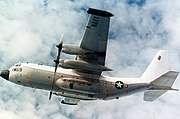
An E-6 airborne, painted anti-flash white
TACAMO (Take Charge and Move Out) is a U.S. military system of survivable communications links designed to be used in nuclear war to maintain communications between the decision makers (the National Command Authority) and the triad of strategic nuclear weapon delivery systems. Its primary mission is to receive, verify and retransmit Emergency Action Messages (EAMs) to US strategic forces. It does this by maintaining the ability to communicate on virtually every radio frequency band from very low frequency (VLF) up through super high frequency (SHF) using a variety of modulations, encryptions and networks. This airborne communications capability largely replaced the land based extremely low frequency (ELF) broadcast sites that became vulnerable to nuclear strike.
Components[]
There are several components to the current TACAMO system. The main part is the airborne portion, the US Navy Strategic Communications Wing One based at Tinker Air Force Base, Oklahoma which flies three Fleet Air Reconnaissance squadrons (VQ-3, VQ-4 and VQ-7) equipped with Boeing IDS E-6B Mercury TACAMO aircraft. As well as the main base there is a west coast alert base at Travis AFB, California and an east coast alert base at NAS Patuxent River, Maryland.
History[]

A U.S. Navy TACAMO EC-130Q of VQ-4, in 1984.
The acronym was coined in 1961 and the first aircraft modified for TACAMO testing was a Lockheed KC-130 Hercules which in 1962 was fitted with a VLF transmitter and trailing wire antenna to test communications with the fleet ballistic missile submarines. The Naval Air Development Center developed the required technique of 'stalling' the trailing antenna to achieve the long vertical antenna needed.[1] The VLF system is currently known as VERDIN (VERy low frequency Digital Information Network.) The program was expanded from 1966 using modified C-130s designated Lockheed EC-130G/Q carrying a VLF system built by Collins Radio Company. The first two squadrons were established in 1968: VQ-4 was initially operating from Patuxent River Naval Air Test Center in Maryland and VQ-3 was initially formed at Agana, Guam but later moved to NAS Barbers Point, Hawaii. System known as TACAMO (from 'take charge and move out') has been operationally deployed in 1969. TACAMO consisted of twelve Lockheed EC-130Q aircraft equipped with VLF transmitters using long trailing antennas.[1] VLF system was repeatedly upgraded to improve signal strength. By 1971 TACAMO IV incorporated a 200 kW transmitter and dual antenna. Actual transmission power and capabilities remain classified. Airborne ELF was tested but considered infeasible. The aircraft were upgraded to the E-6 Mercury beginning in 1990, and the E-6A was upgraded to the dual-role E-6B from 1998. The E-6 aircraft is based on the Boeing 707. The wings and tail were redesigned to meet new wing loading characteristics. The cockpit was copied from the Boeing 737NG commercial airliner, and the landing gear was modified to handle the added weight. Larger fuel tanks were installed and the fuselage was extensively modified to accommodate the 31 antennas, including the trailing wire antenna and reel assembly.[1] After the upgrade to the E-6B, the TACAMO aircraft – with the addition of an Airborne Launch Control System (ALCS) – took over the Looking Glass mission of the USAF.
Other operators[]
The French Navy operated four Transall C-160H aircraft using the Rockwell/Collins TACAMO gear from the E-6. Squadron was: 01.059 "Bigorre", disbanded in August 2001
See also[]
- Boeing E-4
- Survivable Low Frequency Communications System (SLFCS)
- Ground Wave Emergency Network (GWEN)
- Minimum Essential Emergency Communications Network (MEECN)
- Emergency Rocket Communications System (ERCS)
References[]
- ↑ 1.0 1.1 1.2 Spinardi, Graham (1994). From Polaris to Trident: the development of US Fleet ballistic missile technology. Cambridge [England]: Cambridge University Press. ISBN 0-521-41357-5.
External links[]
The original article can be found at TACAMO and the edit history here.